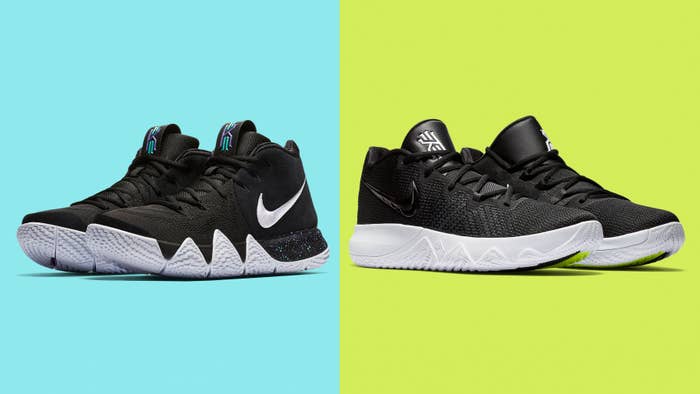
Affordable entries to Nike Basketball’s signature lines have a track record of not just being great values, but great sneakers, period. Devoid of frivolous gimmicks and not-quite-ready-for-basketball tech features, sneakers like the KD 2, Kyrie 1, and PG 1 put all of their resources where they mattered most: performance.
Those aforementioned examples utilized tried and true tech and combined it with “best practices” design elements to create sneakers that just worked. They may not have broken much ground, but they represented the full realization of past innovations.
Thanks to that history, last October’s announcement of an even more affordable addition to Kyrie Irving’s signature line was welcomed with open arms. It offered the potential to not only make the line more accessible to Irving’s fanbase, but offer another viable performance option for players who prefer no-frills models on court.
Based on my cushioning preferences and its unique fit system, the $80 Nike Kyrie Flytrap looks like an even more attractive sneaker than the $120 Nike Kyrie on paper. But how do those features translate to performance?.
Hover over the dots below for a head-to-head breakdown of the two models, and an analysis of which one does it better.
Nike Kyrie 4 vs. Nike Kyrie Flytrap - Fit

Advantage: Nike Kyrie 4
It may not be fancy, but the Kyrie 4’s half-bootie construction allows for a glove-like fit thanks to its sculpted shape and traditional eyestay construction. When fully tightened, the upper fully engages and hugs the foot, offering a reassuring fit that inspires confidence through cuts. Unfortunately, my first time lacing the shoe up resulted in a ripped eyelet. To the shoe’s credit though, the reinforced backing prevented the rip from tearing completely though, and it caused no further issues.
The concept behind the Flytrap’s closure system is a solid one, but the execution falls flat thanks to a sloppy overall shape and sub-par materials. I typically only play in a single pair of socks, but had to double up in order to fill some of the excess space that couldn’t be tightened out of the shoe when fully laced. Going down a half size may help alleviate some of the extra room, but it is more of a volume issue than length.
Nike Kyrie 4 vs. Nike Kyrie Flytrap - Ankle Support

Advantage: Nike Kyrie 4
The Kyrie 4 and Flytrap have different cuts, but both rely on the collar padding to provide heel lockdown. In theory, they should match up well based on utilizing the same philosophy on ankle support, but the corners cut on materials in the Flytrap give a clear advantage to the more expensive Kyrie 4. The padding, while shaped properly, is just not dense enough to actually engage and fully stabilize the heel. The Flytrap’s ankle support isn’t necessarily bad, just not as comfortable or confidence-inspiring as the 4.
Nike Kyrie 4 vs. Nike Kyrie Flytrap - Cushioning

Advantage: Nike Kyrie 4
My favorite cushioning configuration from Nike is Zoom Air in the forefoot and and foam in the heel because I find it provides a perfect combination of responsiveness and impact protection where each is most needed. That should have boded well for the Flytrap, but not all Zoom Air is created equal. The bag found here is comically small—roughly the size and shape of a quarter—and about as effective. It’s placed directly under the ball of the big toe, which is fine, but it’s so low volume that it offers nothing in terms of response. Even the shoe’s insole is of the cheapest persuasion possible; there’s not as much as a Nike logo screen printed on the wafer-thin unit.
Meanwhile, the Kyrie 4 improved greatly in the comfort department over the Kyrie 3, despite using the same configuration of heel Zoom and forefoot foam. I found the 3’s ride to be downright harsh, but the addition of a Cushlon midsole turned the cushioning into one of the high points of the 4. It’s not as protective as a shoe like the LeBron 15 with its massive Zoom Max hybrid units, but for players who want more court feel, it’s an excellent compromise.
Nike Kyrie 4 vs. Nike Kyrie Flytrap - Traction

Advantage: Nike Kyrie 4
Traction is the one area where the Kyrie 4 and Flytrap share the most similarities, and it’s a positive point for both shoes. But despite using a very similar traction pattern, the Kyrie 4 edges out the Flytrap thanks to its level of refinement. The large zig-zag groove that runs up the middle of the sole enhances its radiused shape and offers a sticky surface regardless of the angle from which it engages. It also has the additional benefit of creating a smoother transition. That same groove is implied on the Flytrap, but doesn’t offer the full benefits of the effectively decoupled design of the 4.
Nike Kyrie 4 vs. Nike Kyrie Flytrap - Conclusion


